Clevo P750ZM: GTX 980M Overclocking Investigated
by Jarred Walton on March 20, 2015 10:00 AM ESTClevo P750ZM: Stress Testing
Wrapping things up, for stress testing the P750ZM we run a CPU intensive workload along with a game. After playing with a variety of tools (Prime95, FurMark, etc.) we ended up using Prime95 running the Small FFT Torture Test on four CPU threads (cores 4-7) with Tomb Raider running at 2560x1440 Ultimate on the other four threads (cores 0-3). The total system load starts higher for the first few minutes before CPU throttling drops power use by ~15W. While the maximum power draw ends up being slightly higher, after steady state is reached the power draw is similar to what we saw with many of the games (~245-250W).
This first set of charts shows CPU/GPU core clock speeds and GPU VRAM clocks over a period of 30+ minutes. Even at the stock settings, we can see the CPU throttling kicking in. If there were no throttling, the CPU should be at 4.0GHz or higher, which is clearly not the case. This is why any attempts to overclock the CPU are largely pointless – it can’t maintain maximum Turbo clocks even at stock, so increasing the range doesn’t help beyond the first few seconds.
The GPU and VRAM on the other hand are happily running at their rated speed with no fluctuations over the course of the test. Overclocking the GPU doesn’t change things too much – CPU clocks fluctuate a bit more, but the GPU/VRAM clocks hold steady at their new levels. The aggressive overclock is only moderately stable with the cooling using the default adaptive settings, so we ran the test a second time with fan speeds at maximum (Fn+1). The result is that CPU clocks are higher than on the other tests, though system noise is also quite high (around 48dB from 18”).
Moving on to the temperatures, it’s clear why the CPU is throttling: it routinely hits 98-99C, and while it takes longer to reach steady state at stock settings the net result is still the same. Most desktop systems with the i7-4790K try to keep temperatures below 80C, or 85C at most, so running in the high 90s is definitely a concern. Unless you want to try improving the CPU cooling (i.e. with a different thermal paste, lapping, etc.) you could almost make a case for using an i7-4790… but then that part has a lower maximum clock of 4.0GHz, so on the whole the i7-4790K is still going to be faster.
The maximum fan speed mode is interesting in that CPU temperatures don’t change much, but as noted above the clock speeds are higher. GPU temperatures on the other hand drop quite a bit – the GTX 980M is only running at 68C maximum, which is 1C lower than the stock clocks without the boosted fan speeds. The moderate overclock reaches 71C on the GPU core while the aggressive overclock hits 74C, so even without the boosted fan the core clocks are pretty reasonable.
In fact, it’s likely that any instability caused by overclocking is coming from the VRMs or VRAM heating up as opposed to the GPU core. But the net result is the same: at +225/+350, we appear to be mostly stable, but we’re definitely pushing the limits of what the notebook can handle. Even so, that’s a 20% core overclock and 14% VRAM overclock, all with only a moderate amount of effort.
Quick Check: Gigabyte’s P35W v3
While our full review of the P35W v3 is still in the works and performance is pretty close to the P750ZM in games, it’s also worth taking a moment to look at its results in similar stress testing conditions. Running the stock CPU clocks (on an i7-4710HQ) and GTX 980M, we can immediately see that this particular notebook doesn’t have nearly as much headroom as the P750ZM.
The GPU clocks are stable, which is great to see, but the CPU has to clock all the way down to 2.4GHz (give or take) on the fastest core, with the average CPU clocks dipping as low as 2.1GHz. Temperatures on the CPU max out at 96C (still plenty hot) while the GPU gets as hot as 82C. That’s probably about as far as you’d want to push this notebook, and surface temperatures near the back of the chassis reached 55C (compared to 40C on the P750ZM). But the stock VBIOS is at least partially unlocked (+135MHz GPU core, +2505MHz GPU RAM [yeah, more than you’ll ever achieve!], +25mV) so we decided to see what it could handle:
Okay, so the P35W v3 doesn’t really seem to get much hotter and looks to run okay, though the charts don’t tell the whole story. Without Prime95 running, Tomb Raider runs at ~46 FPS initially and then drops to ~42 FPS after a few minutes; loading up Prime95 dropped the frame rate to a steady ~37 FPS, so the GPU isn’t able to fully stretch its legs in our stress test workload. The overclock also didn’t help performance for this particular test, which defeats the purpose of overclocking. We didn’t see this sort of behavior on the P750ZM, so we’re apparently running into some other bottlenecks (CPU clocks, perhaps).
In other words, just as you’d expect, not all notebooks sporting a GTX 980M are designed to overclock to similar levels. The P35W v3 is pretty close to tapped out in my opinion – I certainly wouldn’t want to push it harder if I expected to keep using it for a few years. The capabilities of other notebooks will vary as well, and of course you still need to get an unlocked VBIOS to even try overclocking.


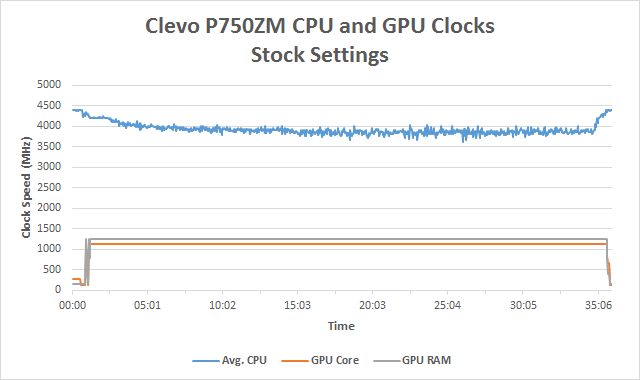
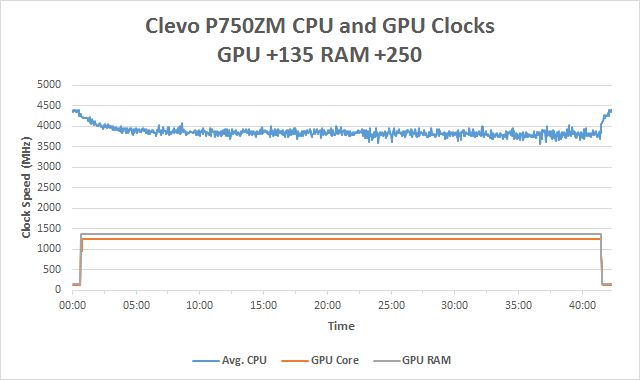
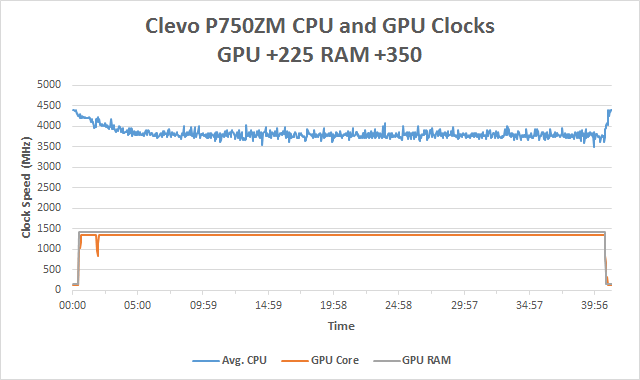
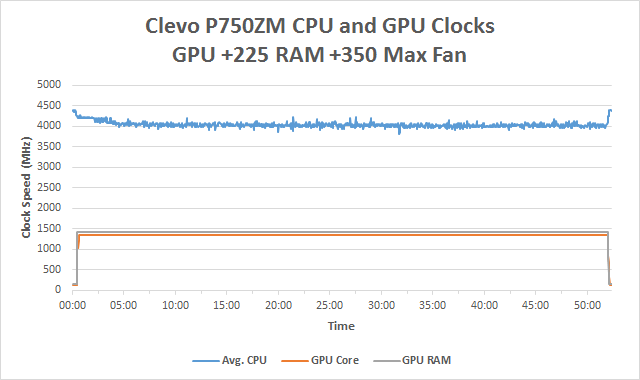
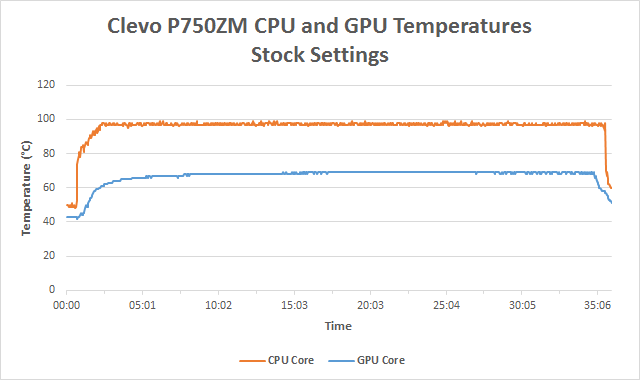
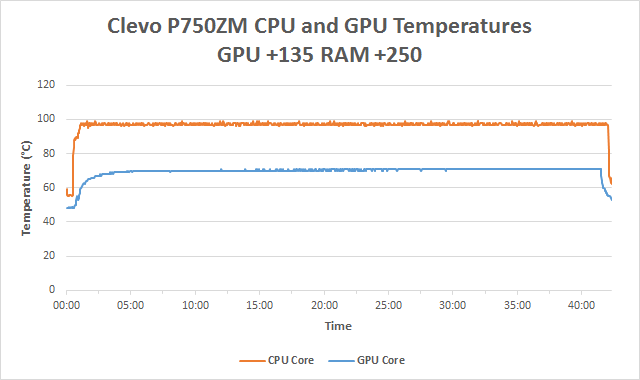
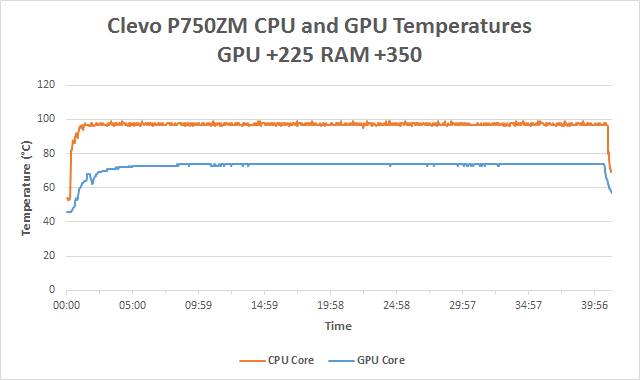

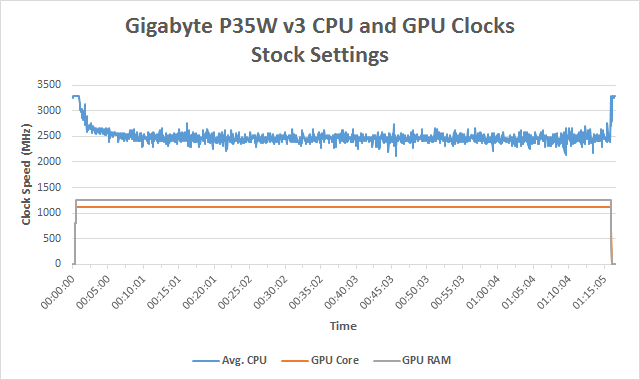
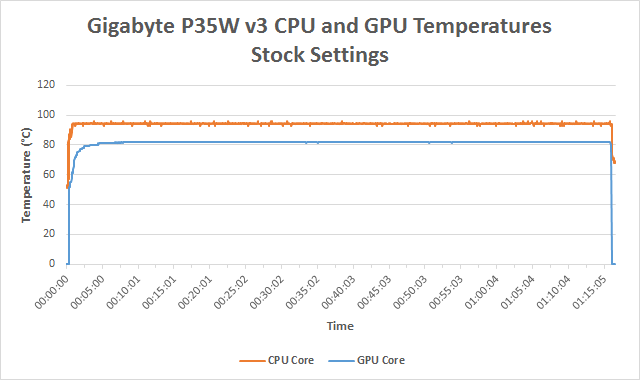
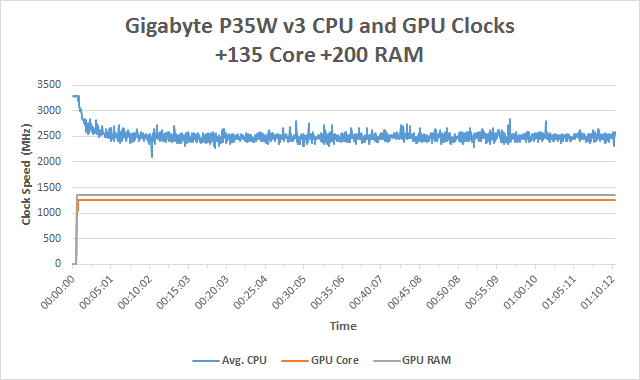
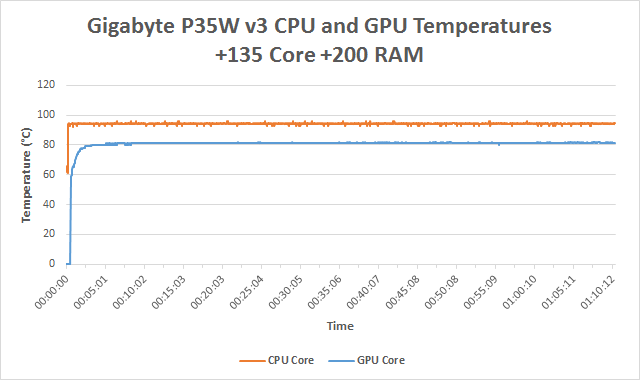








34 Comments
View All Comments
CrazyElf - Friday, March 20, 2015 - link
To be honest, laptops probably don't have the margins for overclocking that a desktop would.For the desktop CPU, it is already pretty hot to begin with. You might be able to knock 15-20C down by delidding that 4790k, much like a desktop. The problem is, with a desktop you can use a giant cooler like the Noctua D15, or water cool. You cannot with a laptop.
GPUs have similar problems. Large triple slot coolers and water blocks are available - indeed they are made specifically for desktop overclocking. There's no way to do that in a laptop. It just isn't possible.
Khenglish - Friday, March 20, 2015 - link
Did you see the GPU temps? With a 20% overclock it only reached around 77C, which is cooler than many stock coolers on similar desktop cards.CPU temps are bad though. I think the problem is that clevo went with a combined GPU/CPU heatsink for this laptop, which is something they have not done before. While this sounds good at first, it makes having good die contact on both CPU and GPU nearly impossible without a large amount of flex in the heatsink, which the P750ZM heatsink does not have.
CrazyElf - Friday, March 20, 2015 - link
Apples to oranges. Maxwell is a pretty cool running chip on desktops too. If you are comparing the 980M to the AMD 290X, then yes, the desktop chips are hot in comparison. But remember, we should be comparing the 980M to a desktop Maxwell, and this is a chip that has 1/4 of the units stripped (so 1536 out of 2048 active) compared to the desktop part, which is already pretty cool running.A delid as I said might solve the problem partly like in desktops of the 4790k, but either way, there isn't much OC headroom in that chip even with the delid.
To be honest, the GT72 is a better choice IMO:
http://www.anandtech.com/show/8694/msi-gt72-domina...
The CPU runs cooler and the battery life is better, should you ever need it. It is somewhat slower, but not by much. Plus newer versions with an IPS screen are available - I just wish Anandtech had reviewed it with the IPS screen.
I just wish that instead of overclocking, that a full 2048 version of the 980 were available, running at a lower clockspeed. My wet dream would be the big 3072-Titan X die severely underclocked on a laptop, but that would never happen for various reasons.
Khenglish - Saturday, March 21, 2015 - link
Yeah full 2048 would rock. I am 100% convinced that the only reason it just has 1536 running is so Nvidia can release a fully enabled chip in the future and say they have a new, faster card.JlHADJOE - Saturday, March 21, 2015 - link
Actually, looking at the combined CPU and GPU temps, it's pretty obvious that system is more or less maxed out thermally.The CPU is pegged at 95-99C, and the GPU is similarly pegged at 77C. When the GPU clock is raised is that the CPU clock goes down, so "overclocking" here merely trades CPU clocks for GPU.
Not that it's a bad idea really, as shown by the game benchmarks, but it does show that there is close to no headroom at all in the Clevo's combined thermals.
Hrel - Friday, March 20, 2015 - link
I think overclocking with today's hardware is stupid, I have no interest in it. I tend to agree with Nvidia on OC.However, that doesn't mean they should go so far as to BLOCK people from being able to do it. Ultimately once they've bought it, it's their choice. At least it should be.
Have OC void the warranty and be done with it. There's no reason to do anything more than that. "You wanna overclock? Fine, do so at your own peril. We wash our hands of you".
This attitude would bring their position from being the right one for 99.9% of the market to 100%.
will54 - Friday, March 20, 2015 - link
I thought they already voided the warranty on OC's or is it just when you go with a modded vbios that they void the warranty ?Buk Lau - Friday, March 20, 2015 - link
Nice work Jarred, glad to see authoritative sites like AT starts to acknowledge OC on mobile GPU! Although you still didn't test with USB 3.1 ports on this machine (so you didn't have peripherals available?)... and in the future I would recommend when you are doing stress tests, just run Prime95 and and Furmark instead for maximum heat on the system. Running Prime95 and tombraider at the same time actually reduces CPU load, because floating point calculation requires much higher work load than game physics. That aside you did a fantastic job! Funny when you noted on potential reasons why Nvidia blocked OC, every generation some cards are just rebrands of old cards with a slightly higher clockspeed. So essentially you can get a free upgrade yourself when you do that, and OC damaging the gpu might not as much of a threat if Nvidia is doing it themselves every generation LOLajc9988 - Friday, March 20, 2015 - link
I disagree with your choice of tests. Max heat isn't the goal with a laptop UNLESS YOU LITERALLY PUSH THE HEAT ON YOUR MACHINE DAILY FOR ITS INTENDED PURPOSE. I had to change the way I thought about overclocking when I came to a laptop. It isn't about max heat like desktop testing (which now reflecting on it is a little stupid if you never do real world activities that push it like that). You want to test max heat for real world type tests. Anything you may do (x264 for avx encoding, etc. There is a long list of stress tests that fully stress the machine without giving synthetic instruction sets to push the hardware to a heat max.). Also, Furmark and Kombuster are vbios blocked in the premamod bios.JlHADJOE - Saturday, March 21, 2015 - link
Yipes! Close to 100°C on the CPU. That is insane.They should run heatpipes to a round metal plate where you can set a mug somewhere on that thing. Cools the CPU, and keeps your drink warm!